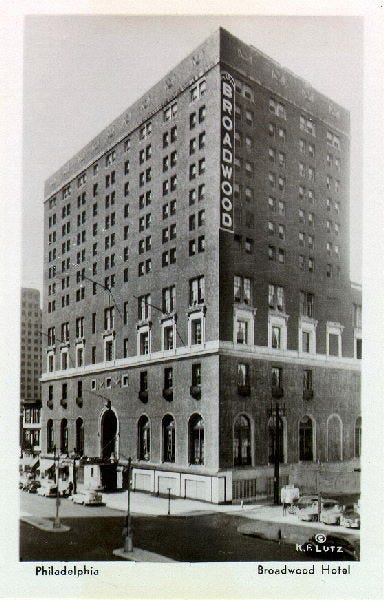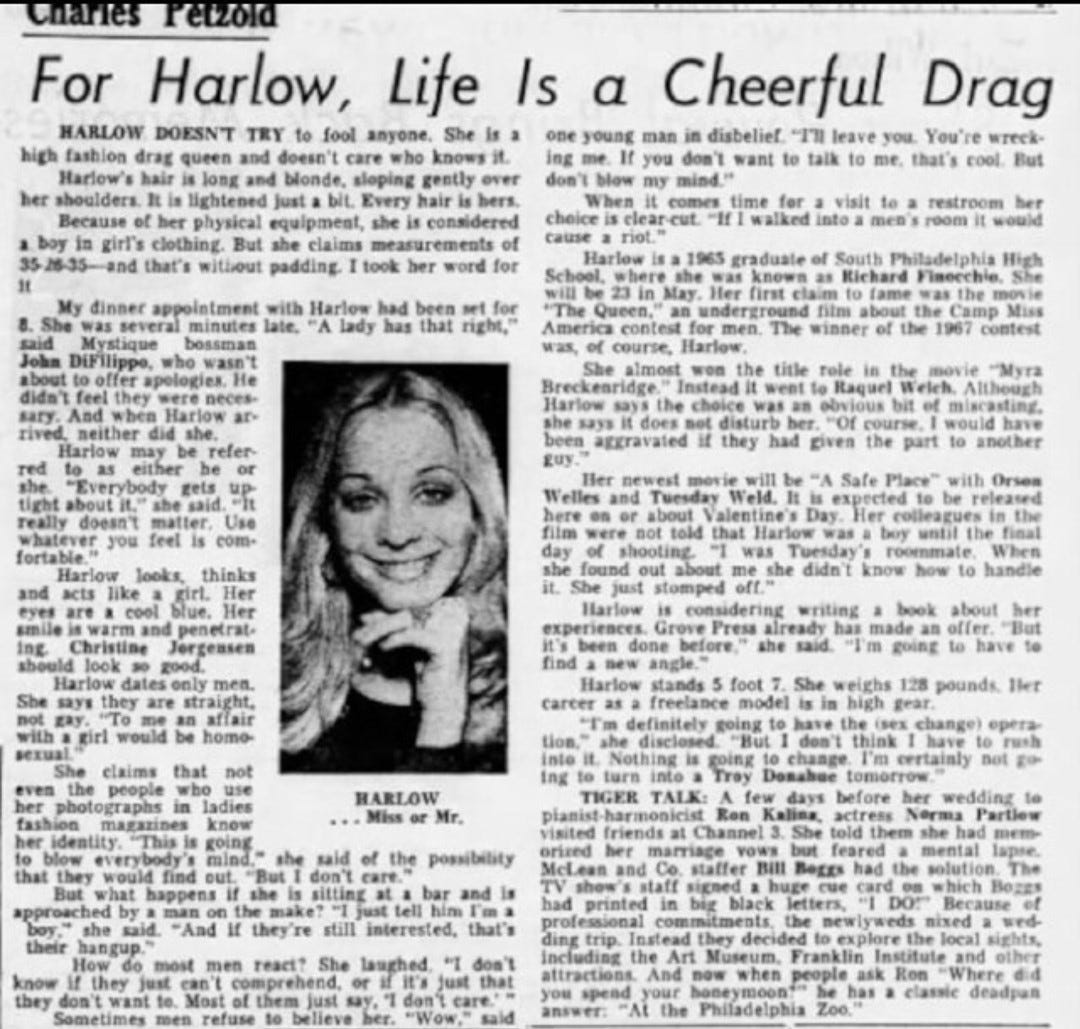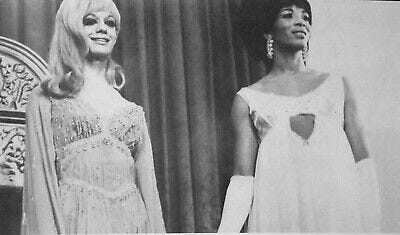From the minute Rachel Harlow is introduced in 1968 drag documentary The Queen, it’s clear she’s going to win the 1967 Miss All-American Camp Beauty Contest. She’s strutting confidently through the crowd of a New York City street toward the camera, wearing a smart black coat, a white mock turtleneck, and large round sunglasses, her fine blonde hair in an androgynous swoop. She looks every bit like an incognito Edie Sedgwick, who fittingly enough was a judge at the competition (the documentary and contest was in part funded through Andy Warhol’s starpower and connections — by the way, you can watch the whole film on Youtube, albeit with Russian subtitles, here).
The opening scenes preceding Harlow’s arrival depict contest organizer/emcee and documentary narrator Flawless Sabrina putting on her face and waxing philosophical about drag life and the inner world of queens, intercut with a judgmental contest organizer giving his two cents about queens as well, while contestants get ready in his apartment. “A lot of ‘em know their street corners, and their bars…and their favorite YMCA and their favorite bathhouse,” he says about the size of their world. He shrugs. “Eh, but they’re beautiful.” But the difference in “their” beauty and the singled-out Rachel Harlow is made clear: they came to the apartment undressed, and only become “beautiful” with a full beat and wig. Harlow’s on the streets of New York, casually passing.
The camera undoubtedly has a greater fascination with Harlow than with any of the other queens due to her seemingly effortless femininity. One of the organizers even comments on it, explaining Harlow’s bratty attitude as a consequence of being a “natural wonder.” Indeed, Harlow does win the competition – despite a rather sloppy wigjob – setting runner-up and Miss Manhattan Crystal LaBeija off on a now infamous read (on YouTube here) that some queens and dolls in New York can probably still quote verbatim to this day. It’s understood that LaBeija, a Black queen, was railing against the racism rampant in white-organized integrated drag shows and balls, and she famously went on to form the House of LaBeija, helping to modernize the Black ballroom scene into the extravagantly organized competitions seen in Paris is Burning. However, there was another element to her complaint: Flawless Sabrina, lead organizer of the competition, was from Philadelphia, and so was Harlow. “She better get the hell back to Philadelphia,” declared LaBeija of Harlow. And so she did.
Born in Philadelphia in 1948 (making her only 19 during the events of The Queen), Harlow grew up in South Philly, at 1620 S Juniper St., right around the corner from The Dolphin Tavern. Her father was a butcher, and her mother a housewife. Sadly, when her father died in 1968 (the year The Queen premiered), she was not listed as one of his children in the obituary. As tireless trans blogger and author Zagria notes in her short bio of Harlow, she was bullied as a young boy for being so pretty, to the point of being (in her own words) suicidal. But as a teen, she found the drag world, where she met Flawless Sabrina, or Jack Doroshow (1939-2017), who became a sort of mentor to her. Doroshow put on an incredible number of pageants a year, and hosted the annual Miss Philadelphia pageant at the (now demolished) Broadwood Hotel at Broad and Vine (Zagria calls this the “Hotel Philadelphia” but I can find no evidence of that name at this location). When Harlow won this contest in 1967, she went on to the Miss All-American Camp Beauty Pageant in New York. It’s easy to see how LaBeija saw collusion between the two.
Julia’s written about a different Italian-American South Philly queer, Tommi Avicolli Mecca, before (here, in the context of his friendship with Cei Bell - and in a dissertation chapter that will someday see the light of day!). Since Harlow chose to remain in Philadelphia all her life, she and Avicolli Mecca would have been young gender subversives in the city at the same time, at about the same age. Yet they led different enough lives that it’s possible they never crossed paths. Avicolli Mecca was at Temple joining the Gay Activist Alliance, pursuing journalism in Philly’s gay rags, and in 1972 founded Radical Queens and the first Gay Pride March in Philadelphia alongside fellow Philadelphian and Black trans woman Cei Bell. Avicolli Mecca describes his dress in the early 70s as “radical drag,” subverting the beauty norms that were omnipresent in the drag world and instead pursuing experimentation, weirdness, and politicized gender nonconformity.
Harlow took a different path. A student of the drag scene at the same time that Avicolli Mecca was a literal student at Temple, she rode her modest starpower from the Cannes premier of The Queen to become a veritable celebrity in Philadelphia. A 1971 newspaper profile on her lists her measurements (35-26-35, she claims) and gives all the details a curious citizen could ever want to know about exactly what kind of girl this is. The profile has an air of delightful, amused shock: “Harlow looks, thinks, and acts like a girl. Her eyes are a cool blue. Her smile is warm and penetrating. Christine Jergenson should look so good.” A 1973 New York Times article mentioning her nightclub, Harlow’s, says it’s “named for a former male, whose sex‐change operation made her the switch hit of the city.” She opened Harlow’s at 32 South Bank St. in Old City with owner Stanley Rosenbleeth in 1970, at only twenty-two years old. In 1972, while Avicolli Mecca and Bell were launching the Radical Queens and organizing the Gay Pride March, Harlow had saved up $3500 and jumped through the hoops to complete sexual reassignment surgery. Avicolli Mecca was long haired, hippie, radical, and gay – Harlow was regal, composed, glamorous, and straight. Like her namesake, 1930’s Hollywood sex symbol Jean Harlow, she gave “movie starlet” and she knew it.
It’s unclear if Harlow had any actual equity in Harlo’s, but she worked as a hostess and lent her name and image to the nightclub. A random person on the “Vintage Philadelphia” Facebook page says, “Rachel was the owner and a good friend of mine,” but I can’t find anything to verify her actual ownership. For the record, another person in that thread said, “I lent Harlow a dress around 1963 or 64. I never got it back.” Philadelphia journalist A.D. Amorosi calls Harlow’s “nearly-gay” and like “Garbo's Grand Hotel shoved into a sprawling upstairs disco”. He also states it was run by Harlow herself, but a 1973 New York Times article alleging six separate accounts of racial discrimination at the club within a year claims the owner as Rosenbleeth. It’s also referred to as a place then-mayor Frank Rizzo “wouldn’t be caught dead”, in reference to its hip, modern tastes. There was another Harlow’s in Atlantic City (or, if you ask Amorosi, “Rachel’s”, on 22nd and Market — the information about these businesses is conflicted and confusing), also possibly owned by or at least in partnership with Harlow herself, but it seems to have drifted away from collective memory more than the original had. The building at 32 Bank St. is now an overpriced hostel.
So Harlow was not exactly an underground radical princess. While Sylvia Rivera was screaming for support for Street Transvestite Action Revolutionaries in the Village, Harlow was more likely to be found visiting the uptown straight scene, or back at home in Philly working at her club, apparently dealing with racial discrimination scandals. She was a local figure of glitz and glam, even carrying a short but highly publicized relationship with Philly royalty John B. Kelly, Jr from 1975 to 1976. Their story is sad:
John B. Kelly Jr., who met Harlow at her night club, was the brother of Philadelphia icon and Princess of Monaco Grace Kelly, and he was accomplished in his own right as an Olympic rower (Kelly Drive by Boathouse Row is named in his memory) and public figure in Philadelphia. By 1975, he was running for Mayor of Philadelphia against incumbent and notorious demon Frank Rizzo. That same year he met Rachel Harlow, and the two began dating. He was forty-seven, twenty years her senior. As the story goes, Kelly’s mother was so scandalized by the couple and the prospect of Harlow being “First Lady” of Philadelphia that she colluded with Democratic Party members to nip Kelly’s mayoral run in the bud. According to a Philadelphia Inquirer article, Kelly told a friend his mother had said, “It’s one thing running for mayor and having your wife as the first lady, but it’s another thing running for mayor and having your wife as the queen.” Personally, I think that’s made up. Either way, the stress of the “scandal” ended Kelly and Harlow’s relationship, and Frank Rizzo won the election. Of his victory and retribution for his political foes, Rizzo is quoted as saying, “Just wait, after November you'll have a front row seat because I'm going to make Attila the Hun look like a faggot.” (You can read more of his noxious Rizzo-isms here.)
Rachel Harlow fell mostly out of the public eye after that, or rather, she walked away from it. A 1989 Inquirer article says she sought to “become invisible”, in her own words. She married chef/baker Gerard Billebault in 1980 and took his name, opening another restaurant (again called Harlow’s) with him in 1988. The way the article tells it, she was at peace being a neighborhood restaurateur. However, the restaurant closed in 1993, and their marriage ended alongside it. Apart from the occasional 90s profile piece, Harlow has led a quiet life since then, although not entirely separate from the Philadelphia gay world. In 1998, she was a special guest for the Philadelphia 40+ Club for Gay Men during a brunch, telling her life story to them in a black floor-length dress. She is quoted as saying, “That's why I stayed here in Philadelphia . . . my hometown. To make you understand this [trans people’s rights] is an issue that must be understood.'' She was also a guest at the release of Thom Nickels’ historical survey book Gay and Lesbian Philadelphia at the William Way Center in 2000. She allegedly currently lives in Northeast Philadelphia, at 77 years old. There’s been a rumbling here or there that she had been writing an autobiography, but so far nothing has shown of it.
While many who know her name may only know her as, alternatively, the poor thing Crystal LaBeija insulted in The Queen, a symbol of racial discrimination in the gay drag scene, or as a 70s Philadelphia It-Girl, her story contains the same complexities of queer life as any political radical said to have thrown the first brick at Stonewall. She was an out trans woman who got “the surgery” in the post-Christine Jorgensen era when Johns Hopkins’ surgery program was hot on the lips of mainstream America, who lived an openly straight lifestyle while flaunting her gender subversion, who could have moved to New York to get in with Warhol’s Factory but chose to remain in Philly instead, who fronted a popular and publicized nightclub in the era of Rizzo the Raider. Many comments under Zagria’s biography of her come from elder trans people who met or worked with Harlow at the perfume counter at Wanamaker’s department store, where she worked after Harlow’s closed, or in Atlantic City, telling their stories of how she encouraged their transitions. Harlow’s life gives us another glimpse into queer Philadelphia, where threads are formed between the underground and mainstream, gay and straight. Who knows all the intricacies of what she experienced in the gay world, in the gay bars, in the straight bars, in the drag contest green rooms and hotels, in the booths at Harlow’s or at the parfumerie? In some ways, Rachel Harlow’s story makes me feel more connected to the everyday of my own queer life, and my own queer friends, maybe because it’s ultimately a very personal story of self-actualization and fulfillment. (It’s also a story of bar ownership…who can relate??) Wherever she is, I do hope she knows that she’s made her mark on this city, and that she has friends and loved ones surrounding her.
I would like to thank Bob Skiba of the John J. Wilcox Jr. LGBT Archives at the William Way Center for his blog The Gayborhood Guru, which in 2016 was last updated with a Google Map pinpointing about 700 different locations in the Philly area pertaining to gay history. That’s where I first made the connection about Rachel Harlow and Harlow’s nightclub. Please give the map and blog a perusal if you’re so inclined.
Thank you all for reading! I hope to do another little bio on some Philly gay spot or person like this soon. Maybe I’ll even get sources from somewhere other than a search engine.
P.S. If you are a little freak for normal people commenting about history online like I am, please do check out Zagria’s blog and all the comments under her entry about Rachel Harlow. They are fascinating little tidbits; some sweet, some sad, some funny, and one a really amusing situation involving a genealogist who has a change of heart.
SOURCES:
NYT Article on Racial Discrimination: https://www.nytimes.com/1973/07/31/archives/philadelphia-club-accused-of-racial-discrimination.html
NYT Article saying Rizzo wouldn’t be caught dead there: https://www.nytimes.com/1973/11/18/archives/whats-doing-in-philadelphia.html
A.D. Amorosi Clubs Scene: https://www.facebook.com/groups/blackbanananightclubphilly/posts/10159619245402661/
Harlow’s Front and Address: https://digital.library.temple.edu/digital/collection/p15037coll3/id/18617
Zagria Harlow Bio: https://zagria.blogspot.com/2015/01/rachel-harlow-1948-pageant-winner-model.html
Harlow Genealogy: https://jeannettestakeonlife.blogspot.com/2018/05/richard-finocchi-infamous-aka-rachel-s.html
Harlow 1971 Profile: https://www.instagram.com/phillyhistoryfacts/p/BvdxliFDzyO/?img_index=3
Frank Rizzoisms: https://web.archive.org/web/20081215112113/http://www.time.com/time/magazine/article/0,9171,915671,00.html
Random FB Page Vintage Philadelphia: https://www.facebook.com/groups/1434456940102314/posts/3321683414712981/
Inquirer Article Referencing Kelly and Harlow: https://infoweb-newsbank-com.freelibrary.idm.oclc.org/apps/news/document-view?p=WORLDNEWS&t=pubname%3APHIB%21Philadelphia%2BInquirer%252C%2BThe%2B%2528PA%2529&sort=YMD_date%3AD&hide_duplicates=2&fld-base-0=alltext&maxresults=60&val-base-0=%22Rachel%20Harlow%22&docref=news/0EB735C69F784B86
General Info on Harlow’s Past, Reference as “Undisputed Queen of Philadelphia’s cafe society”:
https://infoweb-newsbank-com.freelibrary.idm.oclc.org/apps/news/document-view?p=WORLDNEWS&t=pubname%3APHIB%21Philadelphia%2BInquirer%252C%2BThe%2B%2528PA%2529&sort=YMD_date%3AD&hide_duplicates=2&fld-base-0=alltext&maxresults=60&val-base-0=%22Rachel%20Harlow%22&docref=news/0EB95F33DE207AFB
Inquirer Article Guest at Thom Nickels’ Book Release: https://infoweb-newsbank-com.freelibrary.idm.oclc.org/apps/news/document-view?p=WORLDNEWS&t=pubname%3APHIB%21Philadelphia%2BInquirer%252C%2BThe%2B%2528PA%2529&sort=YMD_date%3AD&hide_duplicates=2&fld-base-0=alltext&maxresults=60&val-base-0=%22Rachel%20Harlow%22&docref=news/0F3F5EA91E88BD2D
Philly Daily News Article Harlow’s Story: https://infoweb-newsbank-com.freelibrary.idm.oclc.org/apps/news/document-view?p=WORLDNEWS&t=pubname%3APDNB%21Philadelphia%20Daily%20News%20%28PA%29&sort=YMD_date%3AD&hide_duplicates=2&fld-base-0=alltext&maxresults=60&val-base-0=Rachel%20Harlow&nbid=P5DC56VQMTYyMDgyMTcxNC45NDk3OTI6MTo3OnJhLTE5NjM&docref=news/0EB2A55E6BD3A139







This was so wonderful to read, love queer philly history <3
Great read but that’s not LaBeija in the last pic, it was the second runner up in the NY pageant where LaBeija placed 4th